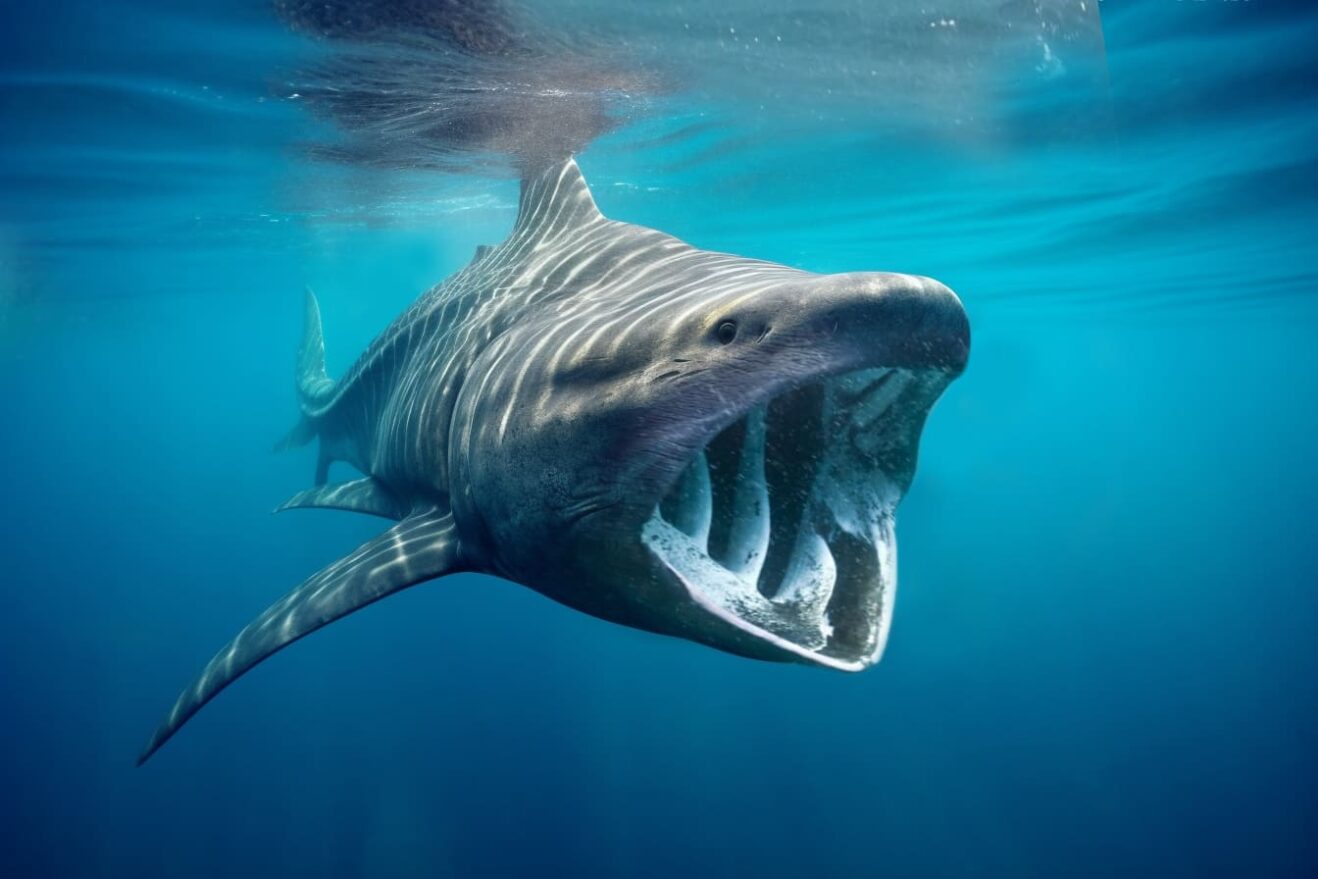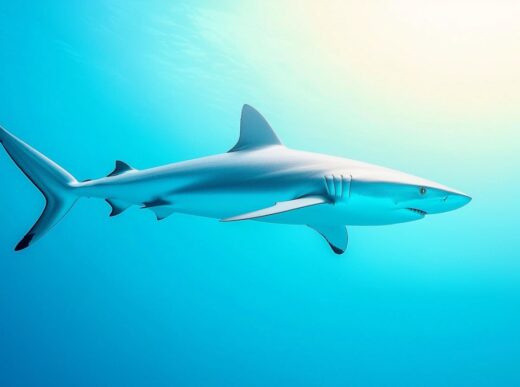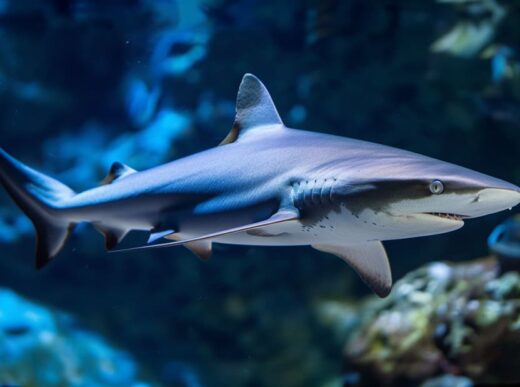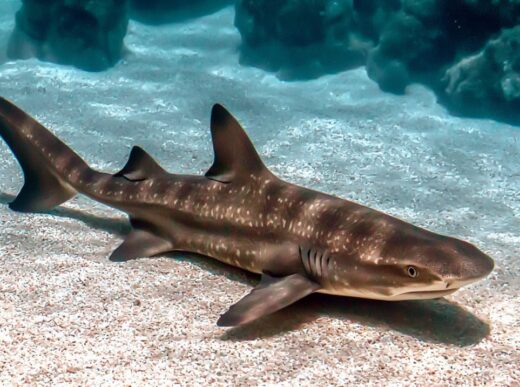Get ready to plunge into the ocean depths with us as we uncover the fascinating world of giant sharks! Meet the basking shark, the second-largest shark after the whale shark, and a true force of nature in the oceans. We’ve rounded up 20 fun and cool facts that will completely change the way you look at these incredible creatures.
20 Amazing Facts About Basking Sharks
So, buckle up for an exhilarating journey through the mysterious waters where basking sharks rule the waves.
Characteristics
1. The basking shark is like the second in command, right after the whale shark when it comes to size. Picture this: a whopping 10 meters long and weighing in at 4 tonnes! And get this, the tiniest basking shark ever caught was just a little baby shark measuring 1.7 meters.
2. Now, this shark’s got a laid-back vibe with its loose, massive body, a head that’s kinda cone-shaped, and a mouth that’s always hanging wide open. Its gill slits? Huge and can puff up.
3. Imagine a cave, but it’s actually the mouth of the basking shark, stretching up to a meter wide, filled with rows and rows of tiny 5-6 millimetre teeth – more than 200 rows, to be precise.
4. The snout of this shark? Think Pinocchio-level elongated, making it look like it’s got the grandest nose in the ocean. No wonder it’s got the Latin name that literally translates to «big-nosed sea monster.» And hey, they’ve got nicknames too, like «sunfish» or «sailfish.»
5. Now, here’s a fun fact: About a quarter of the shark’s total weight is all about that liver. It’s a big deal because it’s packed with a carbohydrate called squalene, giving the shark its cool negative buoyancy.
6. Fashion-wise, the shark’s rocking a grey-brown look with a sprinkle of white speckles – total ocean chic!
Habitats
7. Now, this shark’s a bit of a globe-trotter, popping up in oceans worldwide. It’s all about that cool vibe, as it loves hanging out in cooler waters, chilling in temperate latitudes. And get this – it’s even been spotted up in northern Norway, where the cozy Gulf Stream warms things up just right for our basking buddy.
Lifestyle
8. Picture this: basking sharks are like the laid-back cruisers of the ocean. They’re not winning any speed contests, casually gliding along at a max speed of 4 kilometers per hour – basically the ocean’s equivalent of a leisurely stroll.
9. And here’s a quirky move in their playbook: the occasional shark leap. Yep, these giants make some splashy moves, jumping out of the water. It’s like their version of a spa day, shaking off those unwanted hitchhikers like parasites and lampreys that hitch a ride on their massive bodies.
10. In the grand scheme of ocean drama, basking sharks are like the chill protagonists. No natural enemies, just living their best underwater life for a whopping 50 years.
Eating habits
11. It’s a plankton party for the basking shark! These chill giants are on a strict plankton diet. They take a leisurely swim near the surface, jaws wide open, and filter out plankton from the water.
12. Here’s the cool part: their jaws are like a 24/7 buffet. To make plankton absorption a breeze, sometimes they flip over on their backs. Talk about dining with style!
13. Now, here’s the impressive stat: in just an hour, a basking shark can sift through a whopping 2000 liters of water. Why? Well, they’re aiming to snag about 500 kilograms of plankton every day – that’s the shark version of a nutritious feast!
Intelligence and Social Behavior
14. Basking sharks are the lone wolves of the ocean. They’re all about that solo dining experience, usually opting to feed alone. Yet, there have been some rare occasions where lucky onlookers witnessed a gathering of these giants, with swarms reaching around 100 strong. It’s a rare feast for the eyes!
Reproduction
15. When it comes to family planning, basking sharks take it to the next level. Pregnancy for these ocean giants lasts a whopping three years! The number of little ones in the litter is a well-guarded secret of the deep, making these sharks the mysterious parents of the ocean. And guess what? They’re oviparous, meaning their sharklets hatch from eggs right in the womb. Talk about a cozy start to life!
Population
16. In the shark world, basking sharks are considered a bit vulnerable, and we’re making sure they get the VIP treatment—no hunting allowed! While the total population remains a bit of a mystery, scientists have spotted some positive signs. Tagged sharks are flexing their fins in larger numbers, hinting that the basking shark community is on the rise.
17. Humans, however, haven’t always been the best buddies to these gentle giants. Back in the day, basking sharks faced a real threat from us, all because of the fatty goodness in their livers. Luckily, we’ve come to appreciate their majestic presence, and now they’re off the menu. Phew!
Danger To Humans
18. Good news for ocean enthusiasts! The basking shark is a friendly neighbor in the sea. Divers can approach these majestic creatures safely, but it’s like meeting royalty—admire from a distance and avoid giving a literal high-five to their skin. Safety first, even in the underwater kingdom!
Are There Any Aquariums with Basking Sharks?
19. Ready for a wild encounter? One of the best spots to witness the basking shark’s grandeur is on a thrilling tour like «Basking Shark Scotland,» set against the stunning backdrop of the Hebridean Islands.
20. Catching a glimpse of these ocean giants in an oceanarium? Not likely. The basking shark is a true ocean wanderer and doesn’t fare well in captivity. Recreating their plankton-rich feeding grounds proves to be quite the challenge in enclosed environments. Nature’s wonders are best enjoyed in the open sea!




